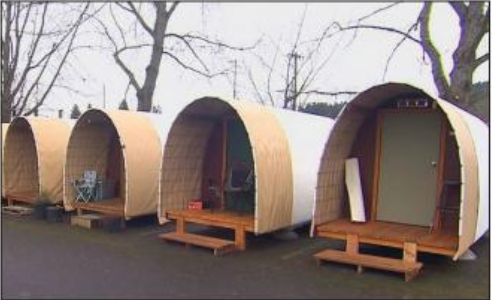In Sonoma County, the homelessness rate is at an all time high consisting of at least 3,000 people. Nearly two-thirds of that population lived in the area before losing their homes, and 62% are continuously without shelter. As a solution to this ongoing problem, volunteers from Sebastopol Community Church built huts, and Petaluma is currently searching for $24 million in state funding to buy multi-tenant housing.
A church member involved with the project, Peggy Porter, stated, “Apparently, having a place where they can lock a door on their belongings and lay down to sleep and stand to dress has made a huge difference for people without shelters,As far as being able to get a job and getting on to a better life, it’s made a huge difference to the people up in Oregon, so I’m hoping it will for our folks, too.”
The community church of Sebastopol created two Conestoga huts to try and combat the problem of homelessness. In the church’s safe parking program, anyone in need will be able to use the structures being provided while they are looking for a permanent home to stay in. Each resembles a covered wagon and about 60 square feet accommodating a bed and limited storage space. People who stay have access to toilets, showers, and kitchens. Approval for stays will be time-limited, although the team is considering the options of having renewals and a six month approval. Furthermore, they expect anyone staying to maintain a relationship with social services as a first step in securing long-term housing.
A church member involved with the project, Judy Davidson stated, “This is just our church, the outreach committee looking into needs of the unsheltered population in Sonoma and wanting to give this a try to see if this would work, and maybe be a model for other places, other churches — a lot of churches with big parking spaces that they could certainly put some of these up in.”
Volunteers used a miter saw to cut pieces of lumber to size, which they then connected to form a structure, painted the front of the hut, and finally laid panels of flexible insulation over the roof. Compared to other temporary homeless shelters, these huts are cheaper to make.
Porter got the design from a nonprofit in Oregon called Community Supported Shelters. Their first step was acquiring a permit from the City of Sebastopol to build two units. Afterwards, they purchased the construction manual from the nonprofit and raised funds to cover the cost of materials. Compared to other temporary homeless shelters, these huts are cheapest to make, coming to about only $2,500.
In addition to Sebastopol’s efforts, Petaluma has been trying to address the increasingly high homelessless crisis. In a unanimous vote, Petaluma City Council members urged city officials to collaborate with housing developments nonprofits for funding through Project Homekey. In July 2020, California launched a $750 million program to help communities obtain motels, hotels, and commercials for people who didn’t have homes during COVID-19. Throughout the state, 94 projects had housed 9,000 people by December 2020.
At the moment, Sonoma County is allowed to buy and convert hotels for permanent supportive housing for their unhoused neighbors. The county received $16 million to buy hotels in Downtown Santa Rosa and Sebastopol that totaled up to 75 units. Project Homekey is very popular therefore the program is getting another $2.75 billion to keep it going.
Karen Shimizu, a city housing manager reported, “This would be a project that would provide the permanent supportive housing units, which is very important to our continuum of housing, so we have our street outreach and we have our interim housing solutions – people would be living there for about six months and then moving into permanent supportive housing.”
As of Sept. 2021, Petaluma City Council will use $338,000 out of the $1.7 million to proceed with the “tiny homes” plan building 25 interim housing units. By January, the project should be completed along with a program assisting residents with mental health, substance abuse treatments, and other on-site services. Currently, there are no possible sites for the project, but city officials are required to put down a location to submit the application that is due on Jan. 31. They are trying to move as quickly as possible because it is a competitive program.
Sonoma County is very proactive when it comes to the problem of homelessness and constantly making new changes to their plans. City officials are doing everything they can to decrease the rate of homelessness in the counties.





![[Both photos courtesy of sonoma.edu]
Ming-Ting Mike Lee stepped in as the new SSU president following Sakakis resignation in July 2022](https://sonomastatestar.com/wp-content/uploads/2024/04/CC4520AB-22A7-41B2-9F6F-2A2D5F76A28C-1200x1200.jpeg)


























